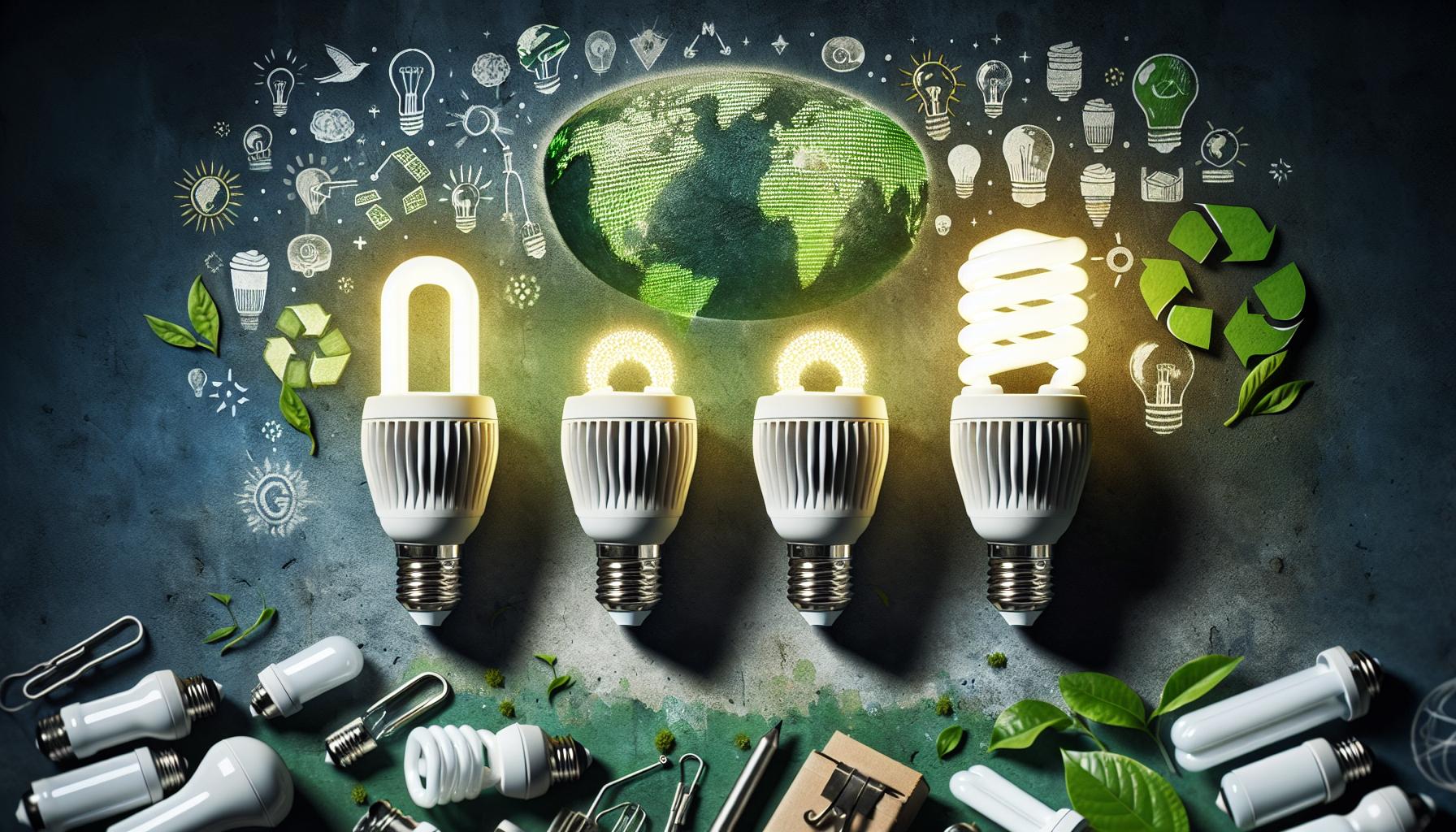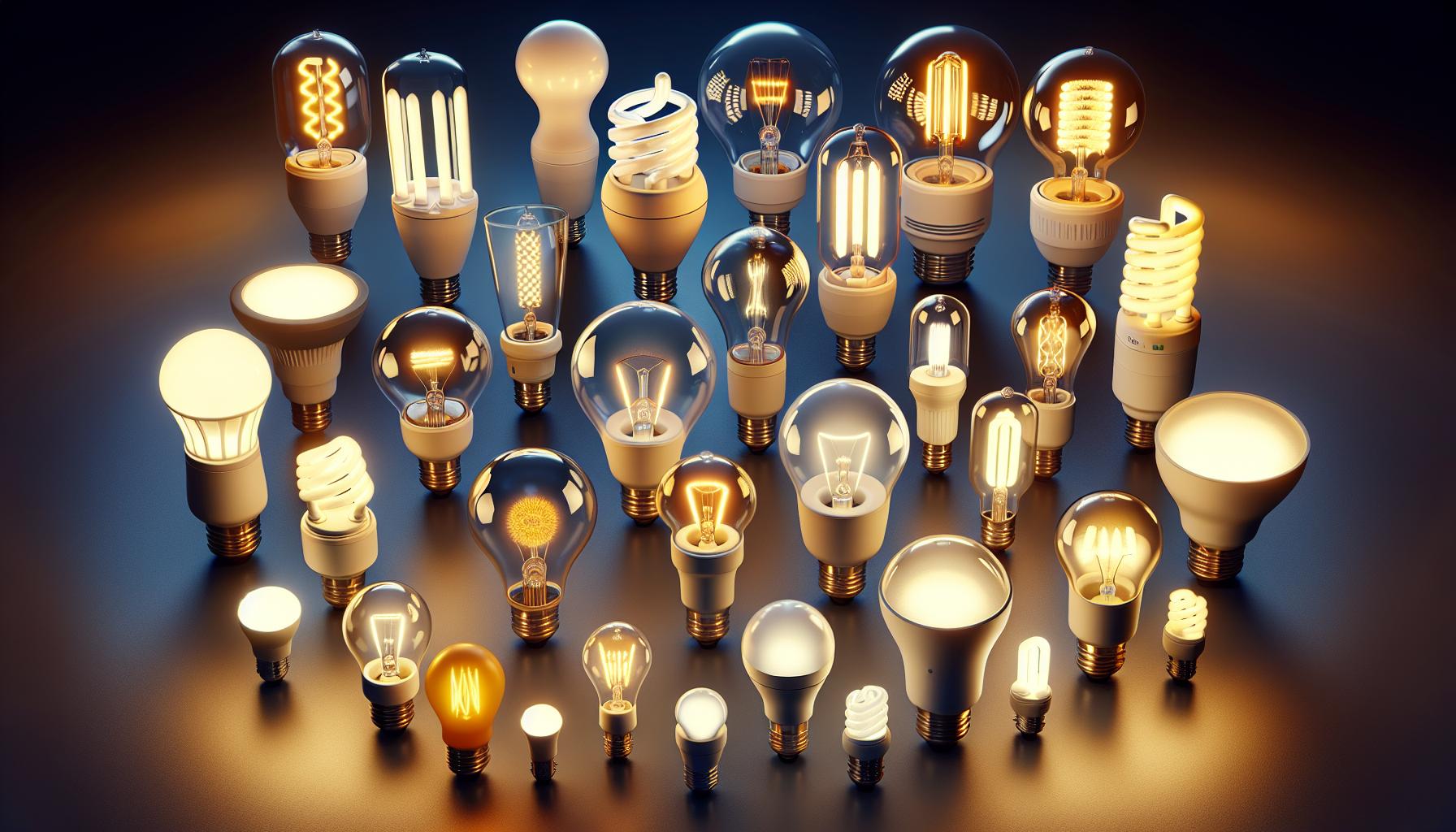Ever wondered how your choice of light bulbs could impact the planet? Well, it turns out that the bulbs you screw into your fixtures can make a big difference. With a growing emphasis on sustainability, it’s high time to shed some light on eco-friendly bulbs that are kinder to Mother Earth.

You’re probably familiar with terms like ‘LED’ and ‘energy-saving’, but what really makes a bulb eco-friendly? It’s not just about the immediate glow; it’s the long-term effect on energy consumption and waste reduction. Let’s illuminate the subject and help you make greener choices that shine in more ways than one.
The Impact of Light Bulbs on the Environment
When you flick on a light switch, the last thing you might think about is how that simple action impacts the environment. Light bulbs, although small, create a sizeable footprint on our planet’s health. It’s crucial to understand this impact to make an informed choice about the bulbs you bring into your home.
Traditional incandescent bulbs are notorious energy guzzlers, converting only about 10% of their energy into light while the rest becomes heat. This not only affects your electricity bill but also hikes up energy production demands. The result? Higher greenhouse gas emissions from power plants, most of which still rely on fossil fuels.
Compact fluorescent lamps (CFLs) presented a more energy-efficient alternative, slashing energy use by nearly 70%. Nevertheless, these bulbs contain mercury, a heavy metal that poses significant environmental hazards if not disposed of correctly. A broken CFL releases mercury into the air, and when these bulbs end up in landfills, they can potentially contaminate soil and water.
Enter LED bulbs, the current front-runners in eco-friendly lighting. LEDs use up to 90% less energy than incandescent bulbs and last up to 25 times longer. This means fewer bulbs end up in landfills, and their long lifespan translates to reduced manufacturing, packaging, and shipping—all of which diminishes their environmental toll.
By opting for LED bulbs, you’re not just brightening your space—you’re committing to a greener future. Your choice can have a palpable effect on the drive towards sustainability and the collective effort to curb energy consumption. As an enthusiast in home DIY and lighting, you know that every detail in your living space counts. Including the bulbs you choose.
- Energy Consumption: Incandescent < CFL < LED
- Lifespan: LED bulbs outlast others
- Hazardous Waste: CFLs contain mercury
It’s also worth mentioning how smart lighting solutions join forces with LED technology to enhance environmental benefits. Smart bulbs can be programmed to optimize usage patterns, further reducing energy waste. With these advancements, you have more control over not only the ambiance of your home but also its ecological footprint.
Understanding Eco-Friendly Light Bulbs

When you’re standing in the light bulb aisle, you might wonder what defines an eco-friendly bulb. Simply put, it’s about efficiency and longevity. Eco-friendly bulbs, such as LEDs (Light Emitting Diodes), significantly reduce both energy consumption and waste. Here’s a closer look at how they achieve this.
First off, LEDs use a fraction of the electricity required by incandescent bulbs. This means less demand on power plants and, as a result, fewer greenhouse gas emissions. Remember, it’s not just about the immediate savings on your electric bill—it’s about the bigger picture of reducing your carbon footprint.
Furthermore, these bulbs are more than just energy savers; they’re also built to last. The average LED bulb can last approximately 25,000 to 50,000 hours. That dwarfs the lifespan of traditional incandescent bulbs, which top out around 1,000 hours. This longevity means fewer replacements, cutting down on material and manufacturing impacts on the environment.
Let’s talk about toxicity. We’ve moved past the days of CFLs with their mercury concerns. LEDs are much cleaner, posing minimal risks to health and the environment when disposed of. However, proper recycling is still recommended to reclaim useful materials and avoid landfill waste.
Besides, the advent of smart LED bulbs has revolutionized the way you control lighting. Imagine tweaking brightness, color, and timing with just a few taps on your smartphone. This isn’t just convenient; it enables precise control over your lighting usage, avoiding unnecessary waste of electricity even when you’re not at home.
While considering eco-friendly bulbs, check for certifications like ENERGY STAR or the DesignLights Consortium qualification. These labels guarantee that the bulb meets strict energy efficiency and performance standards.
« How to Know Your Light Bulb Size: A Shopper’s Quick Guide
How Does Light Bulb Make Our Life Convenient Today: Illuminate Your Space Smarter »
Armed with this knowledge, you’re well-equipped to make a responsible decision next time you need a light bulb. Just remember, every small change contributes to a more sustainable future.
LED Bulbs – An Energy-Saving Solution

When you’re diving into your next DIY home project, keep in mind that LED bulbs are a game-changer in energy-efficient lighting. Sporting long lifespans and requiring significantly less power to operate, LEDs (Light Emitting Diodes) not only brighten up your space but also help keep your energy bills low. They’ve become the go-to solution for eco-conscious homeowners and sustainability enthusiasts.
LEDs stand out for their unique ability to convert electricity directly into light, which means they’re incredibly efficient. In contrast to incandescent bulbs, which waste a lot of energy as heat, LEDs keep their cool, ensuring that power isn’t lost where you can’t see it. Here’s a quick glance at the stark differences:
| Bulb Type | Efficiency | Average Lifespan |
|---|---|---|
| Incandescent | Approx. 10% | 1,000 hours |
| LED | Up to 90% | 25,000 hours |
If you’ve ever experienced the frustration of frequent bulb replacements, you’ll appreciate that LEDs last up to 25 times longer than traditional bulbs. That’s years of reliable lighting before you need to grab your ladder and change a bulb.
Beyond their impressive lifespan, LEDs offer remarkable versatility. Whether you’re creating a cozy atmosphere with warm lighting or need bright white light for a workspace, LEDs have you covered. Color Rendering Index (CRI) scores are high with LEDs, meaning colors appear more vibrant and true-to-life under their glow.
Smart home integration is another area where LED’s innovation shines. With a myriad of smart LED options available, you can tailor your home lighting to your lifestyle using your smartphone or voice commands. Imagine adjusting brightness or setting schedules right from the palm of your hand—it’s lighting control at its most modern and convenient.
So as you plan your home improvements, consider how swapping to LED bulbs can not only transform your living space but also contribute to a healthier planet. Remember, every switch to LED is a step towards a brighter, more sustainable future.
The Benefits of Energy-Efficient Bulbs

As a light bulb and lighting expert who’s passionate about home DIY projects, you’ll find that switching to energy-efficient bulbs is one of the simplest upgrades you can do to make your home more eco-friendly. Energy-efficient bulbs, such as LEDs or CFLs (compact fluorescent lamps), not only consume significantly less electricity but also have a smaller carbon footprint compared to their incandescent counterparts.
Save on Energy Costs
The numbers don’t lie. Let’s look at the typical wattage usage comparison between traditional and energy-efficient bulbs:
| Bulb Type | Incandescent | LED | CFL |
|---|---|---|---|
| Wattage (approx) | 60 | 8 | 14 |
Energy-efficient bulbs can save you up to 80% on your electricity bill by using less power to produce the same amount of light. With utility costs rising, it’s a no-brainer that opting for bulbs like LEDs and CFLs will keep your wallet happy in the long run.
Longevity That Counts
Energy-efficient bulbs are not only gentle on your monthly bills but are also champions of longevity. An LED bulb, for instance, can last up to 25,000 hours – outshining the typical incandescent lifespan by years. This means fewer trips to the store and less hassle in maintenance.
Superior Quality and Flexibility
Beyond the savings, energy-efficient bulbs offer superior light quality and are available in a range of colors and brightness levels to suit any room’s ambiance. They are dimmable and can adapt to various settings, making them a versatile choice for any DIY project.
Whether you’re setting up task lighting in your workshop or creating a cozy nook in your living room, LEDs and CFLs provide the flexibility you need. Plus, their durability means they’re perfect for outdoor fixtures that withstand the elements.
Remember, the next time you’re contemplating an easy DIY upgrade, energy-efficient light bulbs could be the brightest choice you’ll make for your home and the planet.
Choosing the Right Eco-Friendly Bulb for Your Needs

Selecting the ideal eco-friendly light bulb for your home isn’t just about fitting a bulb into a socket. It’s about considering lumens, energy efficiency, and the ambiance you’d like to create. You’re not just picking a bulb; you’re choosing the lighting for your life.
Start with lumens, not watts. When dealing with energy-efficient bulbs, lumens are your measure of brightness, while watts are about energy consumption. For example, to replace a 60-watt incandescent bulb, look for an LED or CFL bulb with about 800 lumens. Here’s a simple comparison:
| Incandescent Wattage | LED Equivalent (Lumens) |
|---|---|
| 40 W | 450 lm |
| 60 W | 800 lm |
| 75 W | 1100 lm |
| 100 W | 1600 lm |
Beyond brightness, consider color temperature. Measured in Kelvins, lower numbers give a warm, yellowish glow perfect for cozy living areas, while higher numbers produce a cooler, bluer light, fitting for task lighting or reading nooks. Think about what you’re lighting up. A warm 2700K is great for lounges while a cooler 5000K might be your choice for kitchens or studies.
Remember to factor in the bulb’s longevity and overall lifetime cost. While LEDs are pricier upfront, their extended lifespan means less frequent replacements and thus, they’re often the cheaper option in the long run. And don’t forget, your eco-friendly bulb choices contribute to reducing carbon emissions, making a positive impact on the environment.
LEDs come out on top for smart home integration. With a variety of options compatible with home automation systems, you can conveniently dim, change colors, or turn on or off your lights with just a simple voice command or swipe on your smartphone.
Imagine the impact of this simple change—upgrading to eco-friendly lighting. You’re not only tailoring light to every corner of your home but also doing your bit for the planet with every flip of a switch. As a DIY enthusiast, think of it as an easy yet meaningful project. Your home’s lighting scheme is a canvas, and you’ve got all the right brushes in hand to make it a masterpiece.
Conclusion
You’ve seen how switching to LED bulbs isn’t just a bright idea for your home—it’s a brilliant move for the planet. By choosing LEDs, you’re not only opting for a superior lighting experience but also contributing to a greener world. Remember to look at lumens and color temperature to find the perfect match for your space. And let’s not forget the convenience of smart technology that comes with some LED options. So why not make the switch today? Your wallet and the Earth will thank you for it.
Frequently Asked Questions
What are the main benefits of LED bulbs?
LED bulbs are highly energy-efficient, produce less waste heat, and have a longer lifespan—up to 25 times longer—compared to traditional incandescent bulbs. They also offer a wide variety of lighting options and color temperatures.
How do LED bulbs contribute to a smart home system?
Smart LED bulbs can be integrated into a smart home system, allowing for remote control via smartphones or voice commands, adding convenience and enhancing home automation.
What should be considered when choosing an eco-friendly bulb?
When selecting an eco-friendly bulb, consider the lumens for brightness, color temperature for the desired hue of light, the bulb’s lifespan, and the total lifetime cost, which factors in both energy consumption and longevity.
How do eco-friendly bulbs impact the environment?
Eco-friendly bulbs, like LEDs, help reduce carbon emissions by using less energy. Upgrading to LEDs and other eco-friendly lighting solutions reduces the overall carbon footprint and contributes to environmental conservation.




